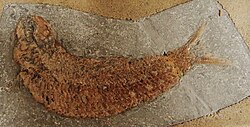Biology:Pholidophorus
| Pholidophorus | |
|---|---|

| |
| Pholidophorus latiusculus fossil | |
| Scientific classification | |
| Domain: | Eukaryota |
| Kingdom: | Animalia |
| Phylum: | Chordata |
| Class: | Actinopterygii |
| Order: | †Pholidophoriformes |
| Family: | †Pholidophoridae |
| Genus: | †Pholidophorus Agassiz, 1832 |
| Species: | †P. latiusculus
|
| Binomial name | |
| †Pholidophorus latiusculus Agassiz, 1832
| |
Pholidophorus (from Greek: φολῐ́ς pholis, 'horny scale' and Greek: φέρω phérō, 'to bear')[1] is an extinct genus of stem-teleost fish. Numerous species were assigned to this genus in the past, but only the type species Pholidophorus latiusculus, from the Late Triassic of Europe, is considered to be a valid member of the genus today.[2][3]
Taxonomy
For a long time, the genus Philodophorus served as a wastebasket taxon containing various unrelated species of basal stem teleosts. Over the years, many of these have been moved to separate genera. The Late Jurassic nominal species "Pholidophorus" purbeckensis was renamed Ichthyokentema by Arthur Woodward in 1941.[4] Likewise, the Early Jurassic form "Pholidophorus" bechei was renamed Dorsetichthys and moved to its own family, Dorsetichthyidae, by Arratia (2013).[5] The nominal species "Pholidophorus" friedeni Delsate, 1999, and "Pholidophorus" gervasuttii Zambelli, 1980, were renamed Luxembourgichthys and Lombardichthys by Taverne and Steurbaut (2017) and Arratia (2017), respectively.[6][2]
Description
Pholidophorus was a herring-like fish about 40 centimetres (16 in) long, although it was not closely related to modern herring. Like them, however, it had a single dorsal fin, a symmetrical tail, and an anal fin placed towards the rear of the body. It had large eyes and was probably a fast-swimming predator, hunting planktonic crustaceans and smaller fish.[7]
A very early teleost, Pholidophorus had many primitive characteristics, such as ganoid scales and a spine that was partially composed of cartilage rather than bone.[7]
References
- ↑ Roberts, G. (1839) (in English). An etymological and explanatory dictionary of the terms and language of geology. London: Longman, Orme, Brown, Green, & Longmans. p. 133. https://archive.org/details/anetymologicala00robegoog. Retrieved 31 December 2021.
- ↑ Jump up to: 2.0 2.1 Arratia, G. (2017). "New Triassic teleosts (Actinopterygii, Teleosteomorpha) from northern Italy and their phylogenetic relationships among the most basal teleosts". Journal of Vertebrate Paleontology 37 (2): e1312690. doi:10.1080/02724634.2017.1312690. Bibcode: 2017JVPal..37E2690A.
- ↑ Taverne, L. (2018). "The Mesozoic fish genus Pholidophorus (Teleostei, Pholidophoriformes), with an osteological study of the type-species Pholidophorus latiusculus. Comments on some problems concerning the "pholidophoriform" fishes". Geo-Eco-Trop. 42 (1): 89–116. https://geoecotrop.be/uploads/publications/pub_421_07.pdf.
- ↑ Griffith, J.; Patterson, C. (1963). "The structure and relationships of the Jurassic fish Ichthyokentema purbeckensis". Bulletin of the British Museum (Natural History), Geology 8 (1): 1–43. doi:10.5962/p.313875. https://biodiversitylibrary.org/page/36370444.
- ↑ Arratia, G. (2013). "Morphology, taxonomy, and phylogeny of Triassic pholidophorid fishes (Actinopterygii, Teleostei)". Journal of Vertebrate Paleontology 33 (sup1): 1–138. doi:10.1080/02724634.2013.835642. Bibcode: 2013JVPal..33S...1A.
- ↑ Taverne, L.; Steurbaut, E. (2017). "Osteology and relationships of Luxembourgichthys ("Pholidophorus") friedeni gen. nov. (Teleostei, "Pholidophoriformes") from the Lower Jurassic of Belgium and the Grand Duchy of Luxembourg". Geologica Belgica 20 (1–2): 53–67. doi:10.20341/gb.2017.003.
- ↑ Jump up to: 7.0 7.1 Palmer, D., ed (1999). The Marshall Illustrated Encyclopedia of Dinosaurs and Prehistoric Animals. London: Marshall Editions. pp. 38–39. ISBN 1-84028-152-9.
Wikidata ☰ Q734856 entry
 |

